NCERT Exemplar Class 12 Chemistry Chapter 9 Coordination Compounds are part of NCERT Exemplar Class 12 Chemistry . Here we have given NCERT Exemplar Class 12 Chemistry Chapter 9 Coordination Compounds.
NCERT Exemplar Class 12 Chemistry Chapter 9 Coordination Compounds
Multiple Choice Questions
Single Correct Answer Type
Question 1. Which of the following complex formed by Cu2+ ions is most stable?
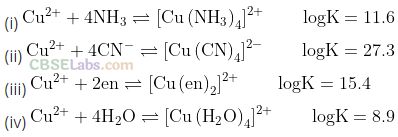
Solution:
(b) The greater the value of log K, the greater will be stability of complex compound formed.
For reaction,

For this reaction, log K has highest value among the given four reactions. Hence, K will also be higher among these four, i.e., stability of the complexes will be highest among these four complexes.
Question 2. The colour of the coordination compounds depends on the crystal field splitting. What will be the correct order of absorption of wavelength of

Solution:

Question 3. When 0.1 mol COCl
3
(NH
3
)
5
is treated with excess of AgNO
3
, 0.2 mol of AgCl are obtained. The conductivity of solution will correspond to
(a) 1:3 electrolyte
(b) 1:2 electrolyte
(c) 1:1 electrolyte
(d) 3:1 electrolyte
Solution:
(b) One mole of AgNO
3
precipitates one mole of chloride ion. In the above reaction, when 0.1 mole COCl
3
(NH
3
)
5
is treated with excess of AgNO
3
, 0.2 mole of AgCl are obtained thus, there must be two free chloride ions in the solution of electrolyte.
So, molecular formula of complex will be [CO(NH
3
)
5
Cl]Cl
2
and electrolytic solution must contain [CO(NH
3
)
5
Cl]
2+
and two CT as constituent ions. Thus, it is 1 : 2 electrolyte.
![]()
Hence, option (b) is the correct.
Question 4. When 1 mol CrCl
3
.6H
2
O is treated with excess of AgNO
3
, 3 mol of AgCl are obtained. The formula of the complex is

Solution:
(d) 3 mol of AgCl means 3Cl are given in the solution hence, the formula of the complex will be [Cr(H
2
O)
6
]Cl
3
.
Question 5. The correct IUPAC name of [Pt(NH
3
)
2
Cl
2
] is
(a) diamminedichloridoplatinum (II)
(b) diamminedichloridoplatinum (IV)
(c) diamminedichloridoplatinum (I)
(d) dichloridodiammineplatinum (IV)
Solution:
(a) [Pt(NH
3
)
2
Cl
2
] is diamminedichloridoplatinum (II) .
Question 6. The stabilization of coordination compounds due to chelation is called the chelate effect. Which of the following is the most stable complex species?
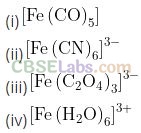
Solution:
(c) Chelation (formation of cycle by linkage between metal ion and ligand) stabilizes the coordination compound. The ligand which chelates the metal ion are known as chelating ligand.
Here, only [Fe(C
2
O
4
)
3
]
3-
is a coordination compound which contains oxalate ion as a chelating ligand. Hence, it stabilizes coordination compound by chelating Fe
3+
ion.
Question 7. Indicate the complex ion which shows geometrical isomerism.

Solution:

Question 8. The CFSE for octahedral [COCl
6
]
4-
is 18,000 cm
-1
. The CFSE for tetrahedral [COCl
4
]
2-
will be
(a) 18,000 cm
-1
(b) 16,000 cm
-1
(c) 8,000 cm
-1
(d) 20,000 cm
-1
Solution:
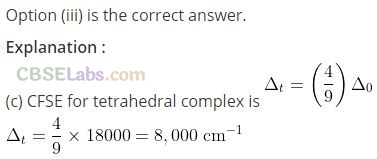
Question 9. Due to the presence of ambidentate ligands coordination compounds
show isomerism. Palladium complexes of the type [Pd(C
6
H
5
)
2
(SCN)]
2
and [Pd(C
6
H
5
)
2
(NCS)
2
] are
(a) linkage isomers (b) coordination isomers
(c) ionization isomers (d) geometrical isomers.
Solution:
(a) The ligands having two different bonding sites are known as ambident ligands e.g., NCS, NO
2
, etc.
Here, NCS has two binding sites at N and S.
Hence, NCS (thiocyanate) can bind to the metal ion in two ways M <- NCS or M —> SNC
Thus, coordination compounds containing NCS as a ligand can show linkage isomerism i.e., [Pd(C
6
H
5
)
2
(SCN)
2
and [Pd(C
6
H
5
)
2
(NCS)
2
] are linkage isomers.
Hence, correct choice is (a).
Question 10. The compounds [Co(SO
4
)(NH
3
)
5
]Br and [CO(SO
4
)(NH
3
)
5
]Cl represent
(a) linkage isomerism (b) ionization isomerism
(c) coordination isomerism (d) no isomerism.
Solution:
(d) [Co(SO
4
)(NH
3
)
5
]Br and [CO(SO
4
)(NH
3
)
5
]Cl represent no isomerism because they are different compounds.
Question 11. A chelating agent has two or more than two donor atoms to bind to a single metal ion. Which of the following is not a chelating agent?
(a) Thiosulphate (b) Oxalato
(c) Glycinato (d) Ethane-1, 2-diamine
Solution:
(a) Thiosulphate or S
2
O
3
–
is not a chelating agent since it is a monodentate ligand.
Question 12. Which of the following species is not expected to be a ligand?
(a) NO (b) NH
4
–
(c) NH
2
CH
2
CH
2
NH
2
(d) CO
Solution:
(b) Ligand must donate a pair of electrons or loosely held electron pair to metal and form a M – L bond,

Question 13. What kind of isomerism exists between [Cr(H
2
O)
6
]Cl
3
(violet) and
[Cr(H
2
O)
5
Cl)Cl
2
.H
2
O (greyish- green)?
(a) Linkage isomerism (b) Solvate isomerism
(c) Ionisation isomerism (d) Coordination isomerism
Solution:
(b) The given compounds havfe different number of water molecules inside and outside the coordinate sphere.
Question 14. IUPAC name of [Pt(NH
3
)2Cl(NO
2
)] is
(a) platinum diaminechloronitrite
(b) chloronitrito-N-ammineplatinum (II)
(c) diamminechloridonitrito-N-platinum (II)
(d) diamminechloronitrito-N-platinate (II).
Solution:
(c) [Pt(NH
3
)2Cl(NO
2
)] is diamminechloridonitrito-N-platinum (II)
More than One Correct Answer Type
Question 15. Atomic number of Mn, Fe and Co are 25, 26 and 27 respectively. Which of the following inner orbital octahedral complex ions are diamagnetic?
Solution:
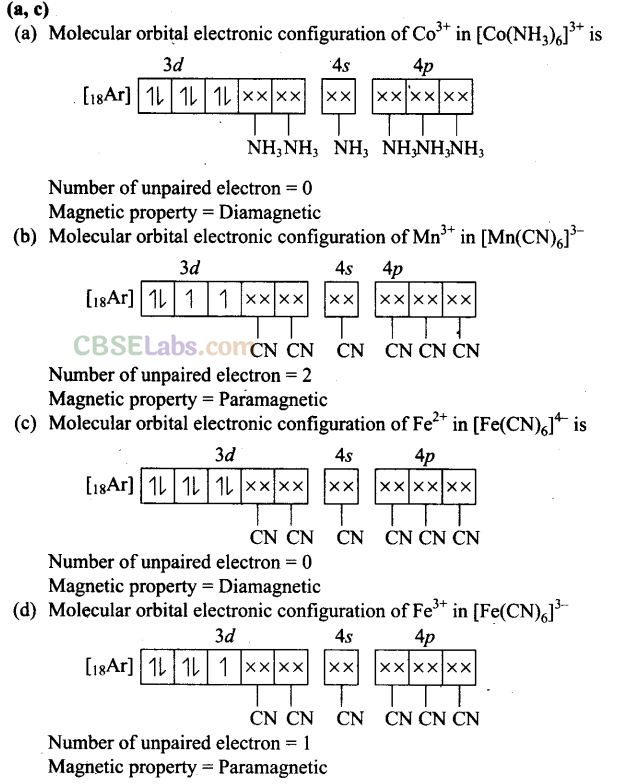
Question 16. Atomic number of Mn, Fe, Co and Ni are 25, 26 27 and 28 respectively. Which of the following outer orbital octahedral complexes have same number of unpaired electrons?
(a) [MnCl
6
]
3-
(b) [FeF
6
]
3-
(c) [CoF
6
]
3-
(d) [Ni(NH
3
)
6
]
2+
Solution:

Question 17. Which of the following options are correct for [Fe(CN)
6
]
3-
complex?
(a) d
2
sp
3
hybridisation
(b) sp
3
d
2
hybridisation
(c) Paramagnetic
(d) Diamagnetic
Solution:

Question 18. An aqueous pink solution of cobalt (II).chloride changes to deep biue on
addition of excess of HCl. This is because
(a) [Co(H
2
O)
6
]
2+
is transformed into [CoCl
6
]
4-
(b) [CO(H
2
O)
6
]
2+
is transformed into [COCl
4
]
2-
(c) tetrahedral complexes have smaller crystal field splitting than octahedral complexes
(d) tetrahedral complexes have larger crystal field splitting than octahedral complex
Solution:
(b, c) Aqueous pink solution of cobalt (II) chloride is due to electronic transition of electron from t2g to eg energy level of [Co(H
2
O)
6
]
2+
complex. When excess of HCl is added to this solution

Question 19. Which of the following complexes are homoleptic?

Solution:
(a, c) In complexes [Co(NH
3
)
6
]
3+
and [Ni(CN)
4
]
2-
, both Co and Ni are attached to one kind of ligands only hence, they are homoleptic.
Question 20. Which of the following complexes are heteroleptic?

Solution:
(b, d) In complexes, [Fe(NH
3
)
4
Cl
2
]
+
and [CO(NH
3
)
4
Cl
2
], metal is bonded to more than one kind of ligands hence, they are heteroleptic.
Question 21. Identify the optically active compounds from the following:
(a) [Co(en)
3
]
3+
(b) trans-[Co(en)
2
Cl
2
]
+
(c) cis-[Co(en)
2
Cl
2
]
+
(d) [Cr(NH
3
)
5
Cl]
Solution:
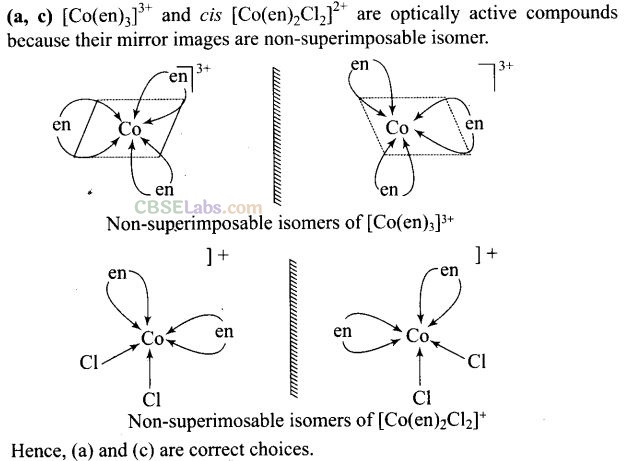
Question 22. Identify the correct statements for the behaviour of ethane-1, 2-diamine as a ligand.
(a) It is a neutral ligand (b) It is a didentate ligand
(c) It is a chelating ligand (d) It is a unidentate ligand
Solution:

Question 23. Which of the following complexes show linkage isomerism?
(a) [CO(NH
3
)
5
(NO
2
)]
2+
(b) [CO(H
2
O)
5
CO]
3+
(c) [Cr(NH
3
)
5
SCN]
2+
(d) [Fe(en)
2
Cl
2
]
+
Solution:
(a, c) NO
2
and SCN are ambidentate ligands hence, show linkage isomerism.
Short Answer Type Questions
Question 24. Arrange the following complexes in the increasing order of conductivity of their solution:
[Co(NH
3
)
3
Cl
3
], [CO(NH
3
)
4
Cl
2
]Cl, [CO(NH
3
)
6
]C13, [Cr(NH
3
)
5
Cl]Cl
2
Solution:
These complexes can ionise in solution as:

Question 25. A coordination compound CrCl
3
.4H
2
O precipitates silver chloride when treated with silver nitrate. The molar conductance of its solution corresponds to a total of two ions. Write structural formula of the compound and name it.
Solution:
It gives white precipitate of AgCl with AgNO
3
it means it has Cl ” ion outside the coordination sphere. Since it gives conductance of two ions the formula will be [CO(H
2
O)
4
Cl
2
]Cl. Its IUPAC name is tetraaquadichloridocobalt (III) chloride.
Question 26. A complex of the type [M(AA)
2
X
2
]
n+
is known to be optically active. What does this indicate about the structure of the complex? Give one example of such complex.
Solution:
An optically active [M(AA)
2
X
2
]
n+
indicates civ-octahedral structure e.g. cis- [Pt(en)
2
Cl
2
]
2+
or cis-[Cr(en)
2
Cl
2
]
+
Question 27. Magnetic moment of [MnCl
4
]
2-
is 5.92 BM. Explain giving reason.
Solution:
The magnetic moment of 5.92 BM corresponds to the presence of five unpaired electrons in the d-orbitals of Mn
2+
ion. As a result the hybridisation involved is sp rather than dsp
2
. Thus tetrahedral structure of [MnCl
4
]
2-
complex will show 5.92 BM magnetic moment value.
Question 28. On the basis of crystal field theory explain why Co(III) forms paramagnetic octahedral complex with weak field ligands whereas it forms diamagnetic octahedral complex with strong field ligands.
Solution:

Question 29. Why are low spin tetrahedral complexes not formed?
Solution:
For tetrahedral complexes, the crystal field stabilisation energy is less and is always lower than pairing energy.

Question 30. Give the electronic configuration of the following complexes on the basis of crystal field splitting theory.
[COF
6
]
3-
, [Fe(CN)
6
]
4-
and [Cu(NH
3
)
6
]
2+
.
Solution:
[COF
6
]
3-
: Co
3+
(d
6
)
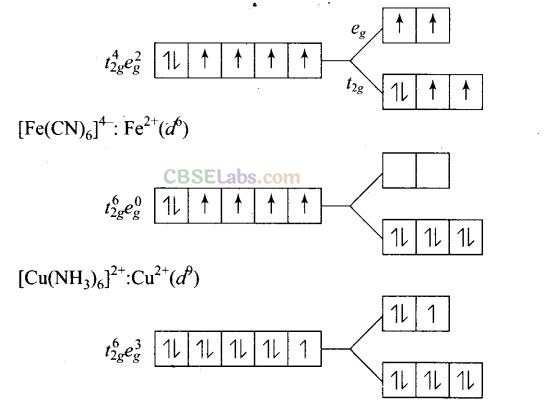
Question 31. Explain why [Fe(H
2
O)
6
]
3+
has magnetic moment value of 5.92 BM whereas [Fe(CN)
6
]
3-
has a value of only 1.74 BM.
Solution:
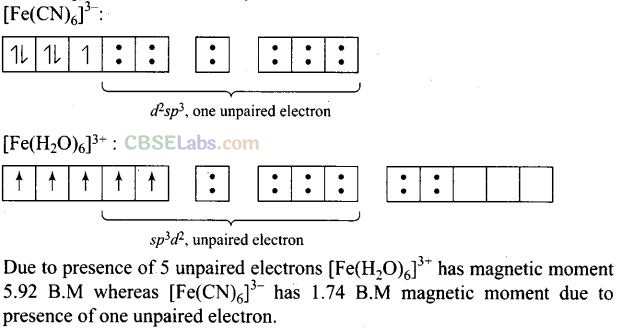
Question 32. Arrange following complex ions in increasing order of crystal field splitting energy (A0):
[Cr(Cl)
6
]
3-
, [Cr(CN)
6
]
3-
, [Cr(NH
3
)
6
]
3+
Solution:
Crystal field splitting energy increases in the order:
[Cr(Cl)
6
]
3-
< [Cr(CN)
6
]
3-
< [Cr(NH
3
)
6
]
3+
Question 33. Why do compounds having similar geometry have different magnetic moment?
Solution:
The compounds having similar geometry may have different number of unpaired electrons due to the presence of weak and strong field ligands in complexes. If CFSE is high, the complex will show low value of magnetic moment and if CFSE is low, the complex will show high value of magnetic moment. For example, the [CoF
6
]3 is paramagnetic moment. For example, the |COF
6
]3 is paramagnetic but [Co(NH
3
)
6
]3+ is diamagnetic.
Question 34. CUSO
4
.5H
2
O is blue in colour while CuSO
4
is colourless. Why?
Solution:
In CUSO
4
.5H
2
O, water acts as ligand. As a result it causes crystal field splitting. Hence, d-d transition is possible in CuSO
4
.5H
2
O and shows colour. In the anhydrous CuSO
4
due to the absence of water (ligand), crystal field splitting is not possible and hence no d-d transitions and no colour.
Question 35. Name the type of isomerism when ambidentate ligands are attached to central metal ion. Give two examples of ambidentate ligands.
Solution:
The ligands which have two binding sites are known as Ambidendate ligands. Some of the examples are: Nitrite-N, Nitrito-O and Isothiocyanato, Thiocyanato.
Linkage Isomerism is a type of isomerism when ambidentate ligands get attached to central metal ions. This happens because it only differs in the atom that they are linked the central metal ion.
Matching Column Type Questions
Question 36. Match the complex ions given in Column I with the colours given in Column II and assign the correct code:
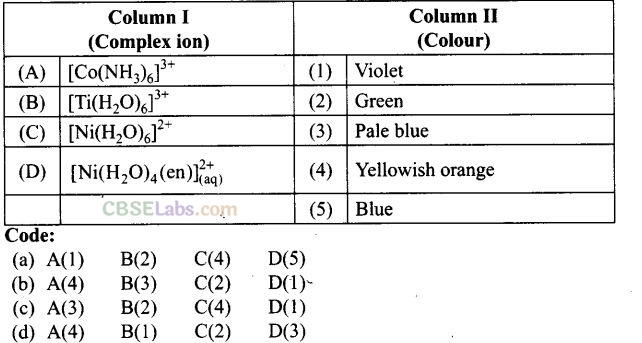
Solution:
(b) (A ->4), (B -> 3), (C —» 2), (D -» 1)
Question 37. Match the coordination compounds given in Column I with the central metal atoms given in Column II and assign the correct code:
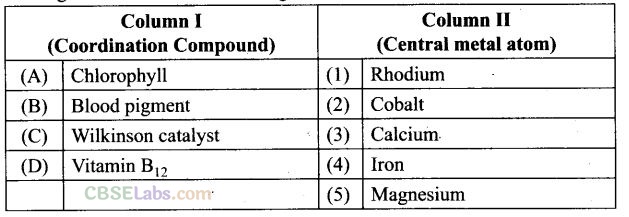
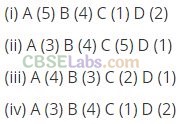
Solution:
(b) (A ->5), (B -> 4), (C —» 1), (D -» 2)
Question 38. Match the complex ions given in Column I with the hybridization and number of unpaired electrons given in Column II and assign the correct code:
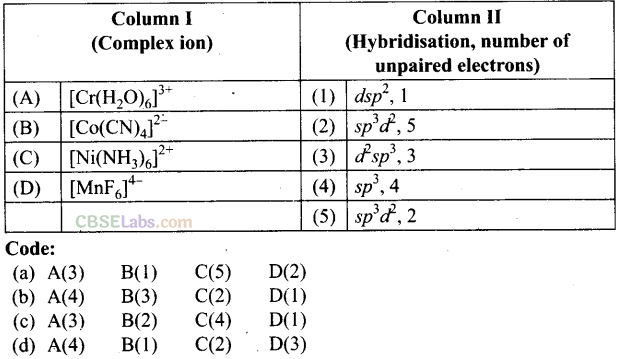
Solution:
(a) (A -» 3), (B —>1), (C —> 5), (D-> 2)
Formation of inner orbital complex and outer orbital complex determines hybridization of molecule which in turn depends upon field strength of ligand and number of vacant d orbitals.
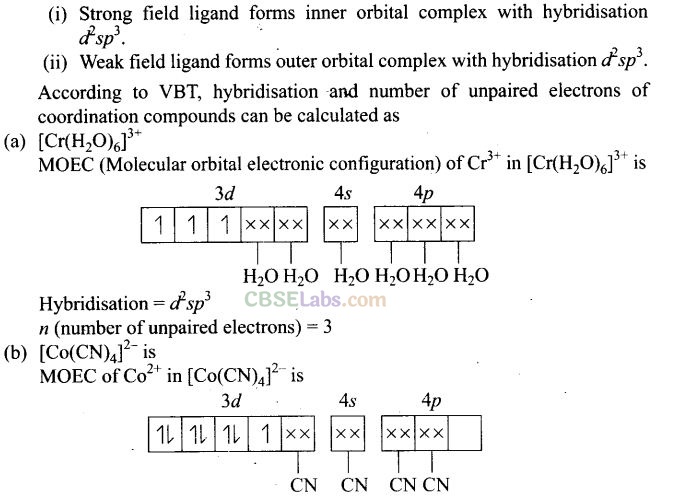
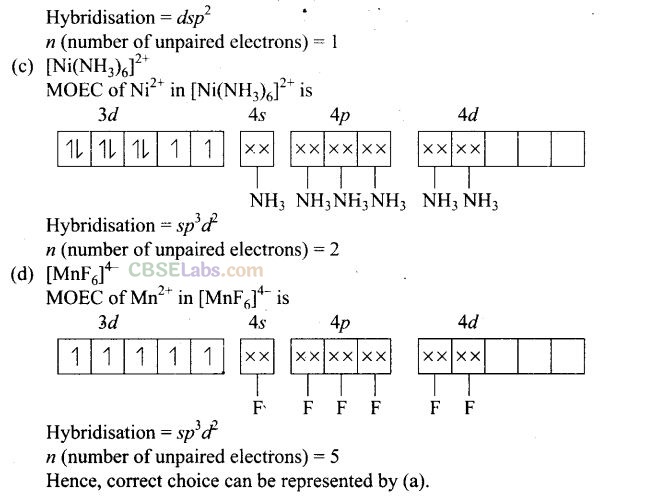
Question 39. Match the complex species given in Column I with the possible isomerism given in Column II and assign the correct code:
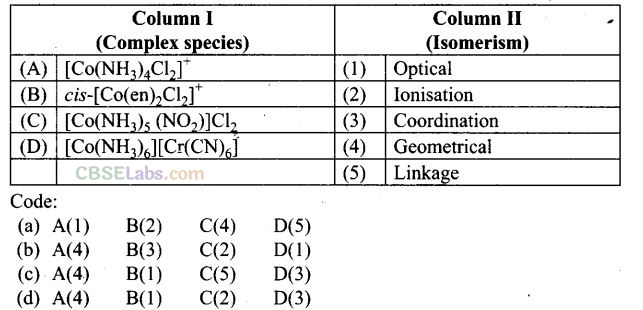
Solution:
(d) (A ->4), (B-> 1), (C ->2), (D ->3)
Isomerism in coordination compound is decided by type of ligands and geometry of coordination and arrangement of ligands.
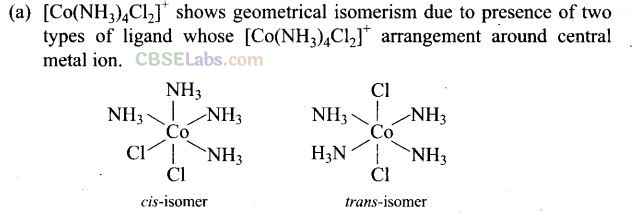
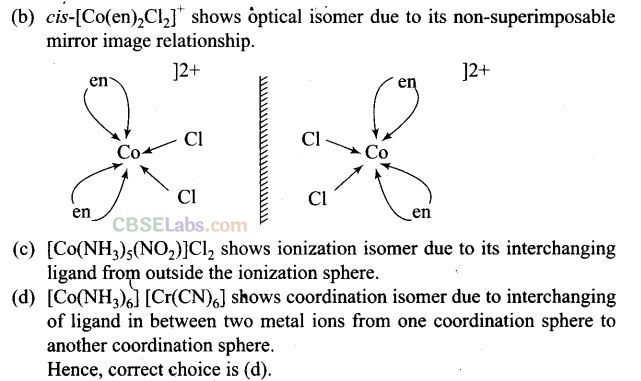
Question 40. Match the compounds given in Column I with the oxidation state of cobalt present in it (given in Column II) and assign the correct code.
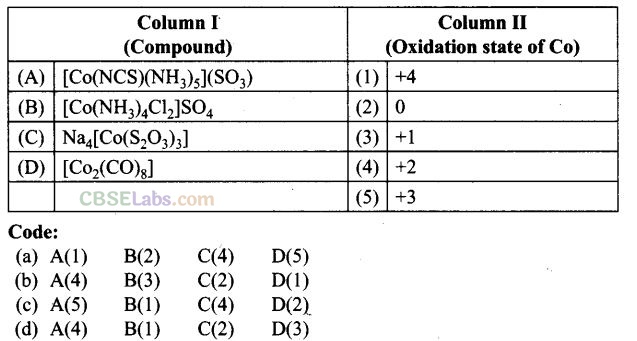
Solution:
(c) (A -> 5), (B -> 1), (C -> 4), (D -> 2)
Oxdiation state of CMI (central metal ion) can be calculated by considering the oxidation state of whole molecule is equal to charge present on coordination sphere.
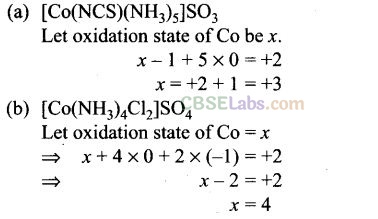
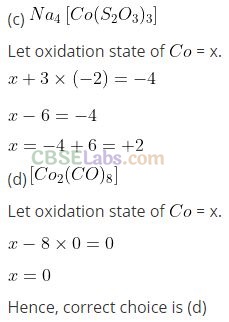
Assertion and Reason Type Questions
In the following questions, a statement of Assertion (A) followed by a statement of Reason (R) is given. Choose the correct option out of the following choices.
(a) Assertion and Reason both are true, Reason is the correct explanation of Assertion.
(b) Assertion and Reason both are true but Reason is not the correct explanation of Assertion.
(c) Assertion is true, Reason is false.
(d) Assertion is false, Reason is true.
Question 41. Assertion (A): Toxic metal ions are removed by the chelating ligands. Reason (R): Chelate complexes tend to be more stable.
Solution:
(a) When a solution of chelating ligand is added to solution containing toxic metals ligands chelates the metal ions by formation of stable complex.
Question 42. Assertion (A): [Cr(H
2
O)
6
]Cl
2
and [Fe(H
2
O)
6
]Cl
2
are reducing in nature. Reason (R): Unpaired electrons are present in their J-orbitals.
Solution:
(b) In the complexes, Co exists as Co
2+
and Fe as Fe
2+
. Both of the complexes becomes stable by oxidation of metal ion to Co
3+
and Fe
3+
.
Question 43. Assertion (A): Linkage isomerism arises in coordination compounds containing ambidentate ligand.
Reason (R): Ambidentate ligand has two different donor atoms.
Solution:
(a) Linkage isomerism arises due to two different donor atoms in ambidentate ligand.
Question 44. Assertion (A): Complexes of MX
6
and MX
5
L type (X and L are unidentate) do not show geometrical isomerism.
Reason (R): Geometrical isomerism is not shown by complexes of coordination number 6.
Solution:
(c) For complexes of MX
6
and MX
5
L type, different geometric arrangements of the ligands is not possible.
MA
4
B
2
, M(AA)
2
B
2
and MA
3
B
3
type of complexes are the complexes with coordination number 6 which show geometrical isomerism.
Question 45. Assertion (A): (Fe(CN)
6
]
3-
ion shows magnetic moment corresponding to two unpaired electrons.
Reason (R): Because it has d
2
sp
3
type hybridisation.
Solution:
(d) (Fe(CN)
6
]
3-
ion shows magnetic moment corresponding to one unpaired electron.
Long Answer Type Questions
Question 46. Using crystal field theory, draw energy level diagram, write electronic

Solution:
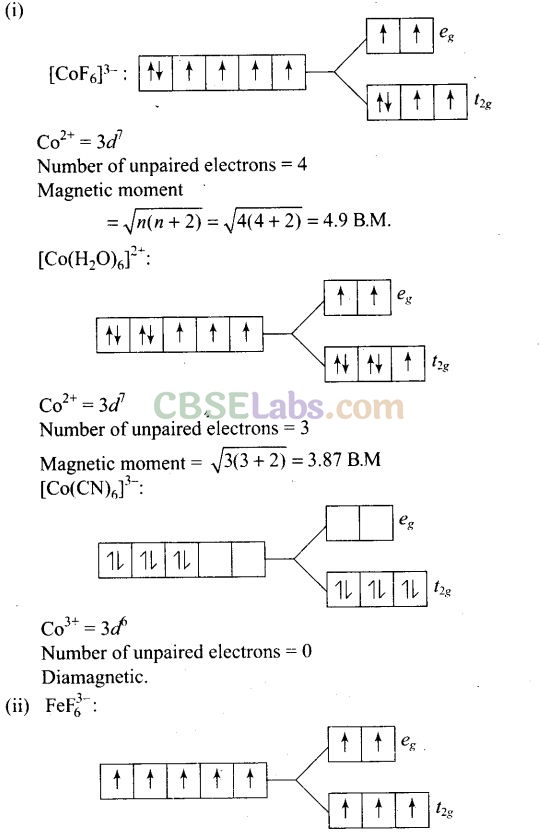

Question 47. Using valence bond theory, explain the following in relation to the complexes gives below:
[Mn(CN)
6
]
3-
, [Co(NH
3
)
6
]
3+
, [Cr(H
2
O)
6
]
3+
, [FeCl
6
]
4-
(i) Type of hybridisation.
(ii) Inner or outer orbital complex.
(iii) Magnetic behaviour.
(iv) Spin only magnetic moment value.
Solution:


Question 48. CoSO
4
Cl.5NH
3
exists in two isomeric forms ‘A’ and ‘B’. Isomer ‘A’ reacts with AgNO
3
to give white precipitate, but does not react with BaCl
2
. Isomer ‘B’ gives white precipitate with BaCl
2
but does not react with AgNO
3
. Answer the following questions.
(i) Identify ‘A’ and ‘B’ and write their structural formulas.
(ii) Name the type of isomerism involved.
(iii) Give the IUPAC name of ‘A’ and ‘B’.
Solution:
CoSO
4
Cl.5NH
3
:
(i) Isomer A reacts with AgN03 but not with BaCl2, it shows it has CP ion outside the coordination sphere.
Hence, A = [Co(NH
3
)
5
SO
4
]Cl
Isomer B reacts with BaCl2 but not with AgNO
3
, it shows it has SO
4
–
outside the coordination sphere.
Hence, B = [CO(NH
3
)5Cl]S0
4
(ii) Ionisation isomerism
(iii) A = Pentaamminesulphatocobalt (III) chloride and B = Pentaamminesulphatocobalt (III) sulphate
Question 49. What is the relationship between observed colour of the complex and the wavelength of light absorbed by the complex?
Solution:
When white light falls on the complex, some part of it is absorbed. The higher the crystal field splitting, the lower will be the wavelength absorbed by the complex. The observed colour of complex is the colour generated from the wavelength left over.
Question 50. Why are different colours observed in octahedral and tetrahedral complexes for the same metal and same ligands?
Solution:
Lower wavelength is absorbed in octahedral complex than tetrahedral complex for the same metal and ligand. In tetrahedral coordination entity, formation of the d-orbital splitting is inverted and is smaller as compared to the octahedral field splitting. For the same metal-ligand complexes, it can be shown that
![]()
NCERT Exemplar Class 12 Chemistry Solutions
- Chapter 1 Solid State
- Chapter 2 Solution
- Chapter 3 Electrochemistry
- Chapter 4 Chemical Kinetics
- Chapter 5 Surface Chemistry
- Chapter 6 General Principles and Processes of Isolation of Elements
- Chapter 7 The p-Block Elements
- Chapter 8 The d- and f-Block Elements
- Chapter 9 Coordination Compounds
- Chapter 10 Haloalkanes and Haloarenes
- Chapter 11 Alcohols, Phenols and Ethers
- Chapter 12 Aldehydes, Ketones and Carboxylic Acids
- Chapter 13 Amines
- Chapter 14 Biomolecules
- Chapter 15 Polymers
- Chapter 16 Chemistry in Everyday Life